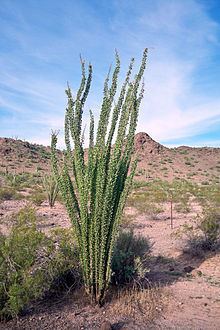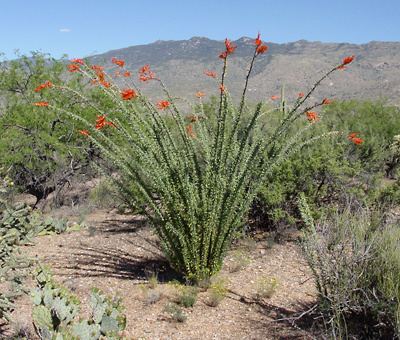Rank Species | Genus Fouquieria Higher classification Fouquieria | |
 | ||
Similar Fouquieria, Cylindropuntia, Saguaro, Parkinsonia florida, Cylindropuntia bigelovii | ||
Planting ocotillo cuttings fouquieria splendens
Fouquieria splendens (commonly known as ocotillo [okoˈtiʝo], but also referred to as coachwhip, candlewood, slimwood, desert coral, Jacob's staff, Jacob cactus, and vine cactus) is a plant indigenous to the Sonoran Desert and Chihuahuan Desert in the Southwestern United States (southern California, southern Nevada, Arizona, New Mexico, western Texas), and northern Mexico (as far south as Hidalgo and Guerrero).
Contents
- Planting ocotillo cuttings fouquieria splendens
- My ocotillo succulent plants fouquieria splendens in flower
- Cultivation
- Uses
- Subspecies
- References

Ocotillo is not a true cactus. For much of the year, the plant appears to be an arrangement of large spiny dead sticks, although closer examination reveals that the stems are partly green. With rainfall, the plant quickly becomes lush with small (2–4 cm), ovate leaves, which may remain for weeks or even months.

Individual stems may reach a diameter of 5 cm at the base, and the plant may grow to a height of 10 m (33 ft). The plant branches very heavily at its base, but above that, the branches are pole-like and rarely divide further, and specimens in cultivation may not exhibit any secondary branches. The leaf stalks harden into blunt spines, and new leaves sprout from the base of the spine.
The bright crimson flowers appear especially after rainfall in spring, summer, and occasionally fall. Flowers are clustered indeterminately at the tips of each mature stem. Individual flowers are mildly zygomorphic and are pollinated by hummingbirds and native carpenter bees.

My ocotillo succulent plants fouquieria splendens in flower
Cultivation

Planting ocotillo can be done year-around with care. Ideal plants have been grown from stem cuttings and from seed. Transplanting large bare-root plants has marginal success. They should be planted to the original growing depth and, as with cacti, in their original directional orientation: the original south side of the plant, which has become more heat- and sunlight-resistant, should again face the brighter, hotter southern direction. If their direction is not marked, success is again limited.

Ocotillo plants prefer well-drained, sandy or gravely loam soil with low to moderate amounts of organic content. Ideal locations are sunny, open, unrestricted and those where surface water does not collect. Transplanted plants require irrigation to become established, but once established, they can survive on 8 inches of rainfall per year.
Uses
Subspecies
The three subspecies are:
